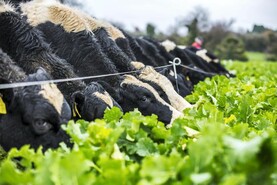The Areas of Natural Constraint (ANC) is a vital scheme for almost 100,000 farm families, with annual funding of €250m allocated. According to the Department of Agriculture’s latest schemes payments for the week ending 23 February 2024, total payments under the 2023 ANC have been recorded at €247.69m paid to 98,860 farmers.
The scheme’s rules for the 2024 ANC is similar to 2023 when it comes to associated terms and conditions. However, there is a big change on the payments front, with advance payments returning to their normal mid-September date and due to commence from 18 September 2024. This is a month earlier than in 2023.
2023 changes
It is worth noting that a number of changes were introduced to the ANC in 2023. Some of these were minor, but it is still worth refreshing these to ensure that you satisfy scheme conditions. Applicants must satisfy that they are carrying out a minimum level of agricultural activity and are deemed an active farmer to receive CAP payments. This will be discussed in detail later.
To satisfy ANC stocking rate requirements applicants must satisfy a minimum stocking rate averaging equal to or greater than 0.1 livestock units (LU) per eligible forage hectare across the 12-month calendar year.
Applicants must also, within the calendar year, maintain a stocking rate equalling or greater than 0.1LU/ha per eligible forage hectare across a 28-week consecutive period. This was previously seven months.
The stocking rate requirement reduced from 0.15LU/ha to 0.1LU/ha, but for a high percentage of farmers there was no real change as the livestock unit values of animals were also lowered for many categories of stock, with the exception of dairy cows and male animals aged greater than two years of age. The LU values are detailed in Table 1. Payment rates are unchanged on 2023 levels and are detailed in Figure 1.
Agricultural activity
As already stated to receive CAP payments applicants must satisfy that they are active farmers – ie carrying out a minimum level of agricultural activity. The level of agricultural activity will be assessed on a holding basis and will be completed on an annual basis by the Department of Agriculture.
The main categorisations used in determining if a farmer satisfies the active farmer status are outlined below for grassland and tillage farmers.
Grassland farmers
Stocking rate will be the main metric used to define the active farmer status of grassland farmers. Farmers satisfying a minimum stocking level of 0.10LU/ha will be deemed active. A caveat to this stocking density is whereby a lower stocking rate may be justified on environmental grounds, similar to the current process under Areas of Natural Constraint.
The stocking rate check will be based on the previous year, with the potential for 2024 to be used.
The terms and conditions state that if an applicant does not meet the minimum stocking rate in 2023, the applicant could choose to:
Meet the minimum stocking rate in 2024, eg if they plan to buy stock in 2024. Applicants would then be using the current year, instead of the previous year, for the stocking rate check in future years. However, opting for the current year for the stocking rate check may result in scheme payments not issuing until March 2025.Provide evidence of making hay/silage or topping, eg a receipt from a contractor in the applicant’s name or a GEOTAG photo demonstrating the activity.Provide evidence of landscape feature maintenance, eg a receipt from a contractor in the applicant’s name or a GEOTAG photo demonstrating the activity. Provide receipts for seed, fertiliser, pesticides, etc in the applicant’s name.Non-grassland farmers
The terms and conditions advise if an applicant is not a grassland farmer, the Department may request evidence of the agricultural activity declared on their Basic Income Support for Sustainability (BISS) application. To be deemed active, they may need to do the following:
Provide evidence of planting or harvesting crops, eg a receipt from a contractor in the applicant’s name or a GEOTAG photo demonstrating the activity.Provide evidence of landscape feature maintenance, eg a receipt from a contractor in the applicant’s name or a GEOTAG photo demonstrating the activity.Provide receipts for seed, fertiliser, pesticides, etc, in the applicant’s name.Provide a copy of a valid share farming agreement.The terms and conditions add that if an applicants’ agricultural activity does not fit into any of the above categories, a free text box will also be presented on the Basic Income Support for Sustainability (BISS) application to allow the applicant to indicate what agricultural activity they are undertaking on their holding. It says this information will be reviewed by the Department and further information may be requested.
Category 1: €148/ha on first 12 eligible hectares, €112/ha on remaining hectares up to a maximum of 34ha. Category 2: €111/ha on first 10 hectares, €104 on remaining hectares up to a maximum of 30ha. Category 3: 93/ha on the first eight eligible hectares, €88.25/ha on remaining hectares up to a maximum of 30ha. Offshore island: €250/ha for the first 20ha, €170/ha for 20ha to 34ha and €70/ha for 34ha to 40ha.
The Areas of Natural Constraint (ANC) is a vital scheme for almost 100,000 farm families, with annual funding of €250m allocated. According to the Department of Agriculture’s latest schemes payments for the week ending 23 February 2024, total payments under the 2023 ANC have been recorded at €247.69m paid to 98,860 farmers.
The scheme’s rules for the 2024 ANC is similar to 2023 when it comes to associated terms and conditions. However, there is a big change on the payments front, with advance payments returning to their normal mid-September date and due to commence from 18 September 2024. This is a month earlier than in 2023.
2023 changes
It is worth noting that a number of changes were introduced to the ANC in 2023. Some of these were minor, but it is still worth refreshing these to ensure that you satisfy scheme conditions. Applicants must satisfy that they are carrying out a minimum level of agricultural activity and are deemed an active farmer to receive CAP payments. This will be discussed in detail later.
To satisfy ANC stocking rate requirements applicants must satisfy a minimum stocking rate averaging equal to or greater than 0.1 livestock units (LU) per eligible forage hectare across the 12-month calendar year.
Applicants must also, within the calendar year, maintain a stocking rate equalling or greater than 0.1LU/ha per eligible forage hectare across a 28-week consecutive period. This was previously seven months.
The stocking rate requirement reduced from 0.15LU/ha to 0.1LU/ha, but for a high percentage of farmers there was no real change as the livestock unit values of animals were also lowered for many categories of stock, with the exception of dairy cows and male animals aged greater than two years of age. The LU values are detailed in Table 1. Payment rates are unchanged on 2023 levels and are detailed in Figure 1.
Agricultural activity
As already stated to receive CAP payments applicants must satisfy that they are active farmers – ie carrying out a minimum level of agricultural activity. The level of agricultural activity will be assessed on a holding basis and will be completed on an annual basis by the Department of Agriculture.
The main categorisations used in determining if a farmer satisfies the active farmer status are outlined below for grassland and tillage farmers.
Grassland farmers
Stocking rate will be the main metric used to define the active farmer status of grassland farmers. Farmers satisfying a minimum stocking level of 0.10LU/ha will be deemed active. A caveat to this stocking density is whereby a lower stocking rate may be justified on environmental grounds, similar to the current process under Areas of Natural Constraint.
The stocking rate check will be based on the previous year, with the potential for 2024 to be used.
The terms and conditions state that if an applicant does not meet the minimum stocking rate in 2023, the applicant could choose to:
Meet the minimum stocking rate in 2024, eg if they plan to buy stock in 2024. Applicants would then be using the current year, instead of the previous year, for the stocking rate check in future years. However, opting for the current year for the stocking rate check may result in scheme payments not issuing until March 2025.Provide evidence of making hay/silage or topping, eg a receipt from a contractor in the applicant’s name or a GEOTAG photo demonstrating the activity.Provide evidence of landscape feature maintenance, eg a receipt from a contractor in the applicant’s name or a GEOTAG photo demonstrating the activity. Provide receipts for seed, fertiliser, pesticides, etc in the applicant’s name.Non-grassland farmers
The terms and conditions advise if an applicant is not a grassland farmer, the Department may request evidence of the agricultural activity declared on their Basic Income Support for Sustainability (BISS) application. To be deemed active, they may need to do the following:
Provide evidence of planting or harvesting crops, eg a receipt from a contractor in the applicant’s name or a GEOTAG photo demonstrating the activity.Provide evidence of landscape feature maintenance, eg a receipt from a contractor in the applicant’s name or a GEOTAG photo demonstrating the activity.Provide receipts for seed, fertiliser, pesticides, etc, in the applicant’s name.Provide a copy of a valid share farming agreement.The terms and conditions add that if an applicants’ agricultural activity does not fit into any of the above categories, a free text box will also be presented on the Basic Income Support for Sustainability (BISS) application to allow the applicant to indicate what agricultural activity they are undertaking on their holding. It says this information will be reviewed by the Department and further information may be requested.
Category 1: €148/ha on first 12 eligible hectares, €112/ha on remaining hectares up to a maximum of 34ha. Category 2: €111/ha on first 10 hectares, €104 on remaining hectares up to a maximum of 30ha. Category 3: 93/ha on the first eight eligible hectares, €88.25/ha on remaining hectares up to a maximum of 30ha. Offshore island: €250/ha for the first 20ha, €170/ha for 20ha to 34ha and €70/ha for 34ha to 40ha. 





 This is a subscriber-only article
This is a subscriber-only article










SHARING OPTIONS: